Evaluating the Erosion Process from a Single-Stripe Laser-Scanned Topography: A Laboratory Case Study
Abstract
1. Introduction
2. Materials and Methods
2.1. Soil Specimens and Geotechnical Tests
2.2. Sloping Flume Erosion Experiment
2.2.1. Rainfall Simulator
2.2.2. Stripe Laser Apparatus
2.2.3. Soil Specimen Preparation
2.2.4. Test Procedure and Measurements
2.3. Erosion Volume Generation and Data Treatment
3. Results
3.1. Soil Loss Measured by the Sediment Yields
3.2. Soil Loss Estimated by the Laser-Scanned Soil Volume Differences
3.3. Laser-Scanned Topographies during Erosion
4. Discussion
4.1. Effects of Rainfall Duration and Slope on Soil Loss
4.2. Relation between the Estimated and Measured Soil Loss
4.3. Erosion Processes and Rill Developlemt
5. Conclusions
Author Contributions
Funding
Acknowledgments
Conflicts of Interest
References
- Shen, H.; Zheng, F.; Wen, L.; Lu, J.; Jiang, Y. An experimental study of rill erosion and morphology. Geomorphology 2015, 231, 193–201. [Google Scholar] [CrossRef]
- Chen, X.-Y.; Zhao, Y.; Mi, H.-X.; Mo, B. Estimating rill erosion process from eroded morphology in flume experiments by volume replacement method. Catena 2016, 136, 135–140. [Google Scholar] [CrossRef]
- Meyer, L.D.; Foster, G.R.; Romkens, M.J.M. Source of soil eroded by water from upland slopes. In Present and Prospective Technology for Predicting Sediment Yields and Sources, Proceedings of the Sediment-Yield Workshop, Oxford, MS, USA, 28–30 November 1972; pp. 177–189.
- Mutchler, C.K.; Young, R.A. Soil detachment by raindrops. In Present and Prospective Technology for Predicting Sediment Yields and Sources, Proceedings of the Sediment-Yield Workshop, Oxford, MS, USA, 28–30 November 1972; pp. 113–117.
- Zhang, P.; Tang, H.; Yao, W.; Zhang, N.; Xizhi, L.V. Experimental investigation of morphological characteristics of rill evolution on loess slope. Catena 2016, 137, 536–544. [Google Scholar] [CrossRef]
- Boardman, J. Soil erosion science: Reflections on the limitations of current approaches. Catena 2006, 68, 73–86. [Google Scholar] [CrossRef]
- Moreno-de Las Heras, M.; Espigares, T.; Merino-Martín, L.; Nicolau, J.M. Water-related ecological impacts of rill erosion processes in Mediterranean-dry reclaimed slopes. Catena 2011, 84, 114–124. [Google Scholar] [CrossRef]
- Lei, T.W.; Zhang, Q.; Zhao, J.; Tang, Z. A laboratory study of sediment transport capacity in the dynamic process of rill erosion. Am. Soc. Agric. Eng. 2001, 44, 1537–1542. [Google Scholar]
- Lawrence, W.; Gatto, L.W. Soil freeze-thaw-induced changes to a simulated rill: Potential impacts on soil erosion. Geomorphology 2000, 32, 147–160. [Google Scholar]
- Dong, Y.Q.; Zhuang, X.H.; Lei, T.W.; Yin, Z.; Ma, Y.Y. A method for measuring erosive flow velocity with simulated rill. Geoderma 2014, 232–234, 556–562. [Google Scholar] [CrossRef]
- Bewket, W.; Sterk, G. Assessment of soil erosion in cultivated fields using a survey methodology for rills in the Chemoga watershed, Ethiopia. Agric. Ecosyst. Environ. 2003, 97, 81–93. [Google Scholar] [CrossRef]
- Aksoy, H.; Unal, N.E.; Cokgor, S.; Gedikli, A.; Yoon, J.; Koca, K.; Inci, S.B.; Eris, E. A rainfall simulator for laboratory-scale assessment of rainfall-runoff-sediment transport processes over a two-dimensional flume. Catena 2012, 98, 63–72. [Google Scholar] [CrossRef]
- Zheng, F.L. A research on method of measuring rill erosion amount. Bull. Soil Water Conserv. 1989, 9, 41–49. [Google Scholar]
- Casalí, J.; Loizu, J.; Campo, M.A.; De Santisteban, L.M.; Álvarez-Mozos, J. Accuracy of methods for field assessment of rill and ephemeral gully erosion. Catena 2006, 67, 128–138. [Google Scholar] [CrossRef]
- Shen, H.; Zheng, F.; Wen, L.; Han, Y.; Hu, W. Impacts of rainfall intensity and slope gradient on rill erosion processes at loessial hillslope. Soil Tillage Res. 2016, 155, 429–436. [Google Scholar] [CrossRef]
- Balaguer-Puig, M.; Marqués-Mateu, Á.; Lerma, J.L.; Ibáñez-Asensio, S. Estimation of small-scale soil erosion in laboratory experiments with Structure from Motion photogrammetry. Geomorphology 2017, 295, 285–296. [Google Scholar] [CrossRef]
- Berger, C.; Schulze, M.; Rieke-Zapp, D.; Schlunegger, F. Rill development and soil erosion: A laboratory study of slope and rainfall intensity. Earth Surf. Proc. Land. 2010, 35, 1456–1467. [Google Scholar] [CrossRef]
- Heng, B.C.P.; Chandler, J.H.; Armstrong, A. Applying close range digital photogrammetry in soil erosion studies. Photogramm. Rec. 2010, 25, 240–265. [Google Scholar] [CrossRef]
- Nouwakpo, S.; Huang, C.-H.; Frankenberger, J.; Bethel, J. A simplified close range photogrammetry method for soil erosion assessment. In Proceedings of the 2nd Joint Federal Interagency Conference, Las Vegas, NV, USA, 27 June–1 July 2010. [Google Scholar]
- Vinci, A.; Brigante, R.; Todiscoa, F.; Mannocchi, F.; Radicioni, F. Measuring rill erosion by laser scanning. Catena 2015, 124, 97–108. [Google Scholar] [CrossRef]
- Afana, A.; Solé-Benet, A.; Pérez, J.L. Determination of soil erosion using laser scanners. In Proceedings of the 19th World Congress of Soil Science, Soil Solutions for a Changing World, Brisbane, Australia, 1–6 August 2010. [Google Scholar]
- Longoni, L.; Papini, M.; Brambilla, D.; Barazzetti, L.; Roncoroni, F.; Scaioni, M.; Ivanov, V.I. Monitoring riverbank erosion in mountain catchments using terrestrial laser scanning. Remote Sens. 2016, 8, 241. [Google Scholar] [CrossRef]
- Dąbek, P.B.; Patrzałek, C.; Ćmielewski, B.; Żmuda, R. The use of terrestrial laser scanning in monitoring and analyses of erosion phenomena in natural and anthropogenically transformed areas. Cogent Geosci. 2018, 4, 1437684. [Google Scholar] [CrossRef]
- Thoma, D.P.; Gupta, S.C.; Bauer, M.E.; Kirchoff, C.E. Airborne laser scanning for riverbank erosion assessment. Remote Sens. Environ. 2005, 95, 493–501. [Google Scholar] [CrossRef]
- Filin, S.; Baruch, A.; Morik, S.; Avni, Y.; Marco, S. Characterization of land degradation processes using airborne laser scanning. In Proceedings of the International Archives of the Photogrammetry, Remote Sensing and Spatial Information Science, Kyoto, Japan, 9–12 August 2010. [Google Scholar]
- ASTM. Standard Test Methods for Specific Gravity of Soil Solids by Water Pycnometer; D854-14; ASTM: West Conshohocken, PA, USA, 2014. [Google Scholar]
- ASTM. Standard Test Method for Sieve Analysis of Fine and Coarse Aggregate; ASTM C136/C136M-14; ASTM: West Conshohocken, PA, USA, 2015. [Google Scholar]
- ASTM. Standard Test Methods for Determining the Amount of Material Finer than 75-μm (No. 200) Sieve in Soils by Washing; D1140-14; ASTM: West Conshohocken, PA, USA, 2014. [Google Scholar]
- ASTM. Standard Test Method for Particle-Size Analysis of Soils; ASTM D422-63; ASTM: West Conshohocken, PA, USA, 2007. [Google Scholar]
- ASTM. Standard Test Methods for Laboratory Determination of Water (Moisture) Content of Soil and Rock by Mass; D2216-10; ASTM: West Conshohocken, PA, USA, 2010. [Google Scholar]
- ASTM. Standard Practices for Preserving and Transporting Soil Samples; D4220/D4220M-14; ASTM: West Conshohocken, PA, USA, 2014. [Google Scholar]
- Eijkelkamp Soil & Water. Available online: https://en.eijkelkamp.com/products/field-measurement-equipment/rainfall-simulator.html (accessed on 3 July 2018).
- Nciizah, A.D.; Wakindiki, I.I.C. Rainfall pattern effects on crusting, infiltration and erodibility in some South African soils with various texture and mineralogy. Water SA 2014, 40, 57–64. [Google Scholar] [CrossRef]
- Salles, C.; Poesen, J.; Sempere-Torres, D. Kinetic energy of rain and its functional relationship with intensity. J. Hydrol. 2002, 257, 256–270. [Google Scholar] [CrossRef]
- Hung, C.-Y.; Capart, H. Rotating laser scan method to measure the transient free-surface topography of small-scale debris flows. Exp. Fluids 2013, 54, 1544. [Google Scholar] [CrossRef]
- Hung, C.-Y. Relation between Debris Flow Rheology and Fan Deposit Morphology Investigated Using Small-Scale Experiments. Master’s Thesis, National Taiwan University, Taipei, Taiwan, June 2011. [Google Scholar]
- ASTM. Standard Test Methods for Liquid Limit, Plastic Limit, and Plasticity Index of Soils; D4318-10; ASTM: West Conshohocken, PA, USA, 2010. [Google Scholar]
- Bu, C.-F.; Wu, S.-F.; Yang, K.-B. Effects of physical soil crusts on infiltration and splash erosion in three typical Chinese soils. Int. J. Sediment Res. 2014, 29, 491–501. [Google Scholar] [CrossRef]
- Di Prima, S.; Concialdi, P.; Lassabatere, L.; Angulo-Jaramillo, R.; Pirastru, M.; Cerdà, A.; Keesstra, S. Laboratory testing of Beerkan infiltration experiments for assessing the role of soil sealing on water infiltration. Catena 2018, 167, 373–384. [Google Scholar] [CrossRef]
- Lin, L.-L.; Tung, H.-P.; Wan, H.-S. Handbook of Soil Physics Experiments; Department of Soil and Water Conservation, National Chung Hsing University: Taichung City, Taiwan, 2002. [Google Scholar]
- Shen, H.O.; Zheng, F.L.; Wen, L.L.; Lu, J.; Han, Y. An experimental study on rill morphology at loess hillslope. Acta Ecol. Sin. 2014, 34, 5514–5521. [Google Scholar] [CrossRef]
- Niu, Y.B.; Gao, Z.L.; Li, Y.H.; Luo, K.; Yuan, X.H.; Du, J.; Zhang, X. Rill morphology development of engineering accumulation and its relationship with runoff and sediment. Trans. Chin. Soc. Agric. Eng. 2016, 32, 154–161. [Google Scholar]
- He, J.-J.; Lu, Y.; Gong, H.-L.; Cai, Q.-G. Experimental study on rill erosion characteristics and its runoff and sediment yield process. Shuili Xuebao 2013, 44, 398–405. [Google Scholar]
- Chen, J.J.; Sun, L.Y.; Cai, C.F.; Liu, J.T.; Cai, Q.G. Rill erosion on different soil slopes and their affecting factors. Acta Pedol. Sin. 2013, 50, 281–288. [Google Scholar]
- Liu, Q.Q.; Li, J.C.; Chen, L.; Xiang, H. Dynamics of overland flow and soil erosion (II): Soil erosion. Adv. Mech. 2004, 34, 493–506. [Google Scholar]
- Yao, C.; Lei, T.; Elliot, W.J.; McCool, D.K.; Zhao, J.; Chen, S. Critical conditions for rill initiation. Trans. ASABE 2008, 51, 107–114. [Google Scholar] [CrossRef]
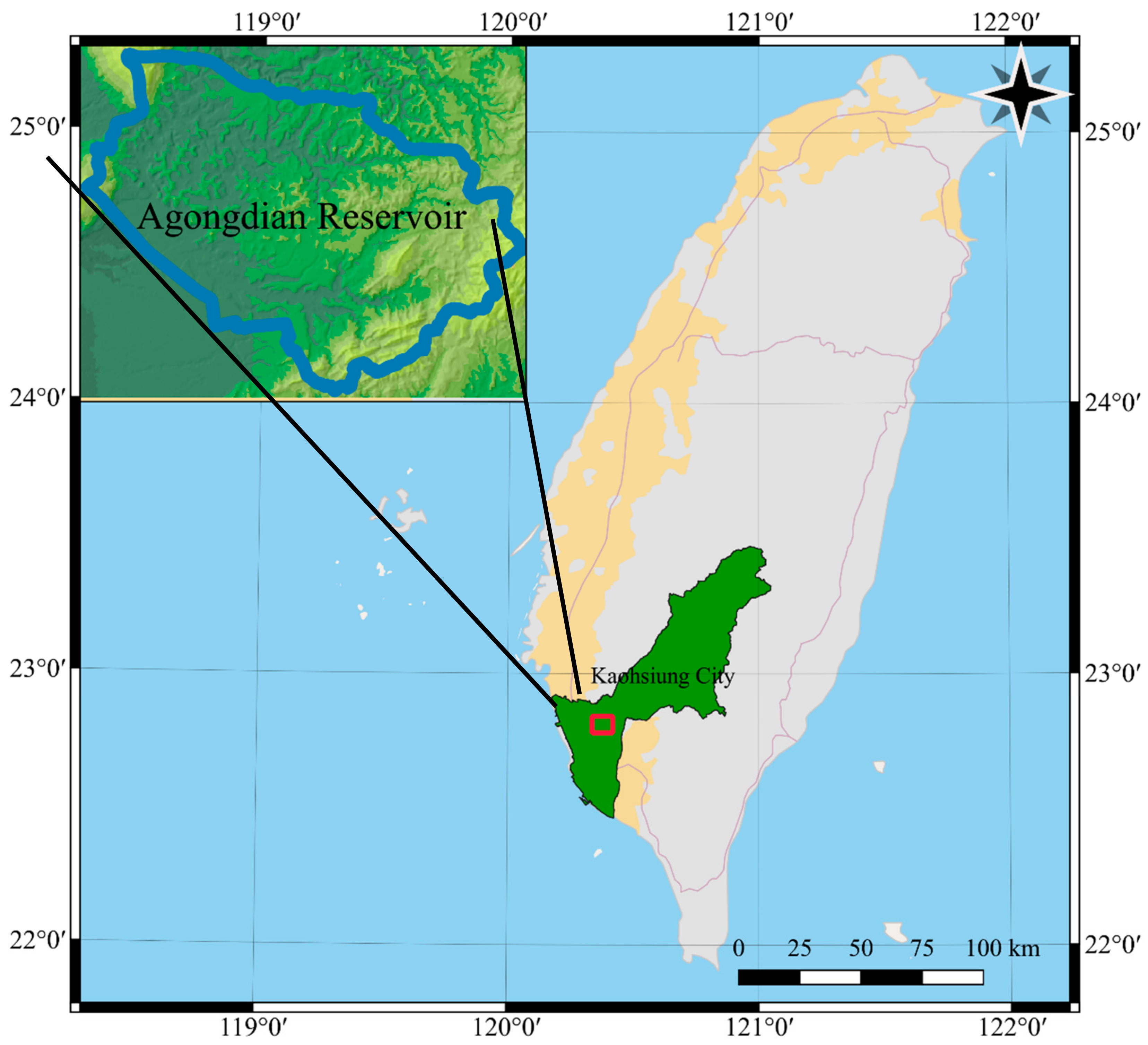
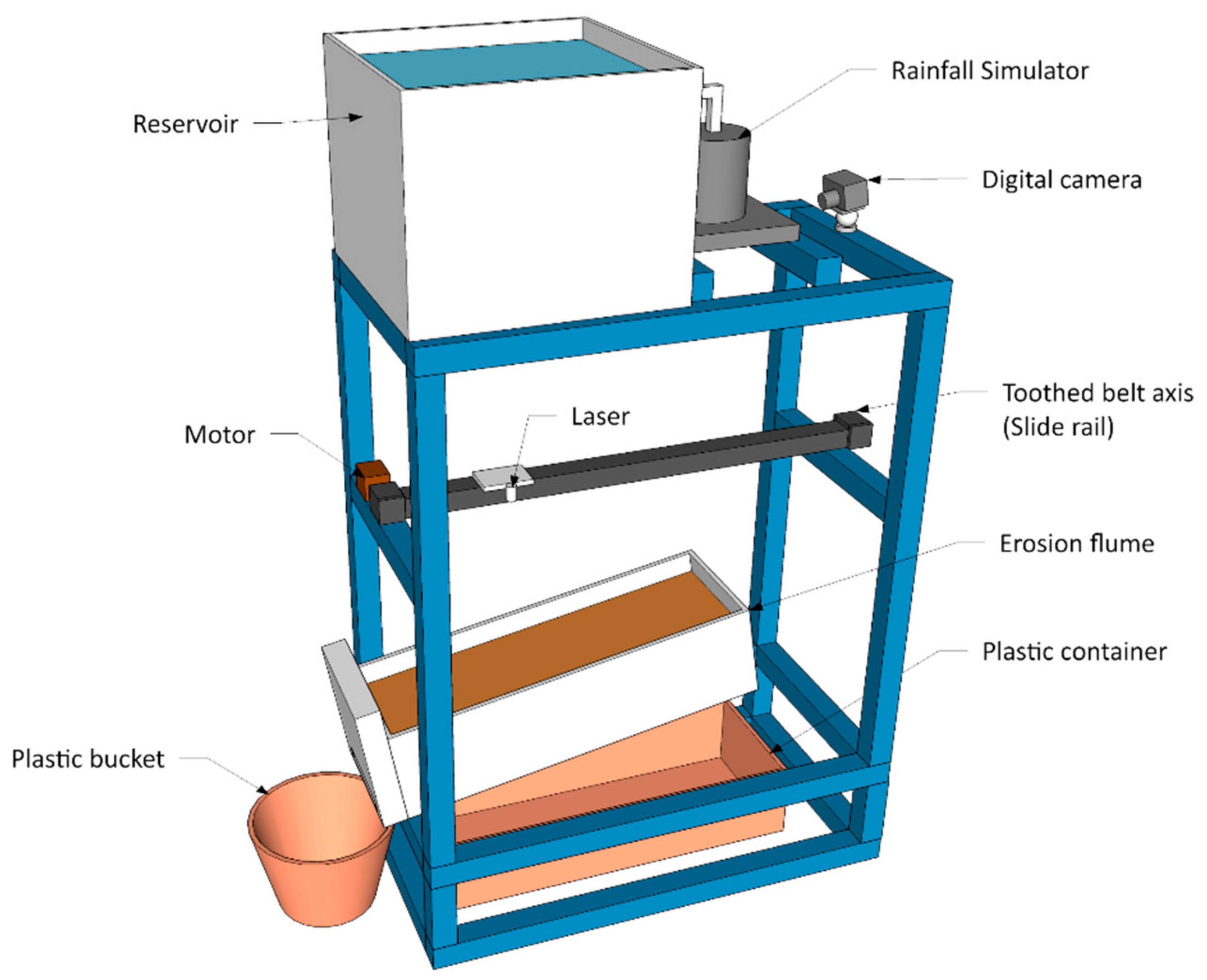
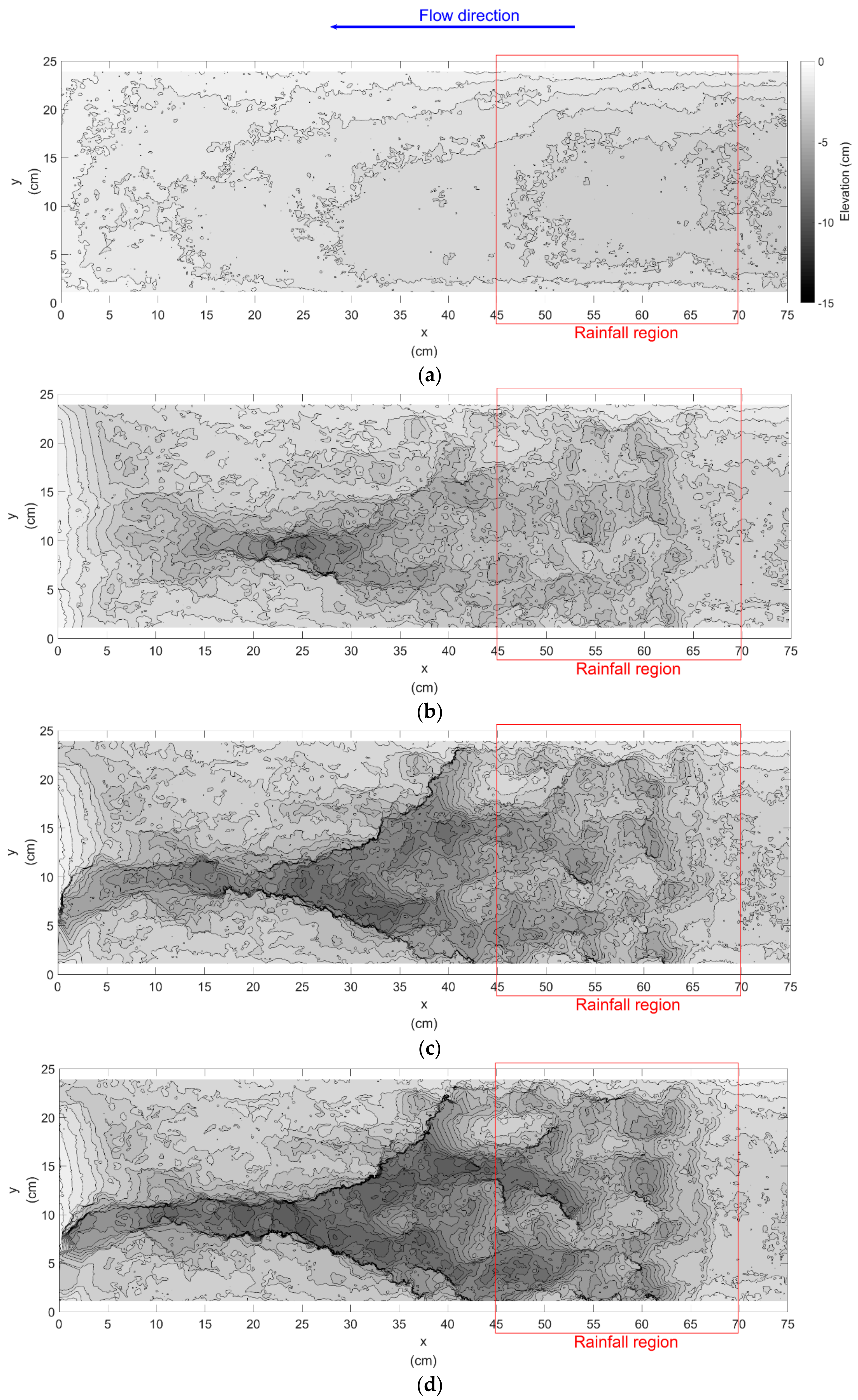

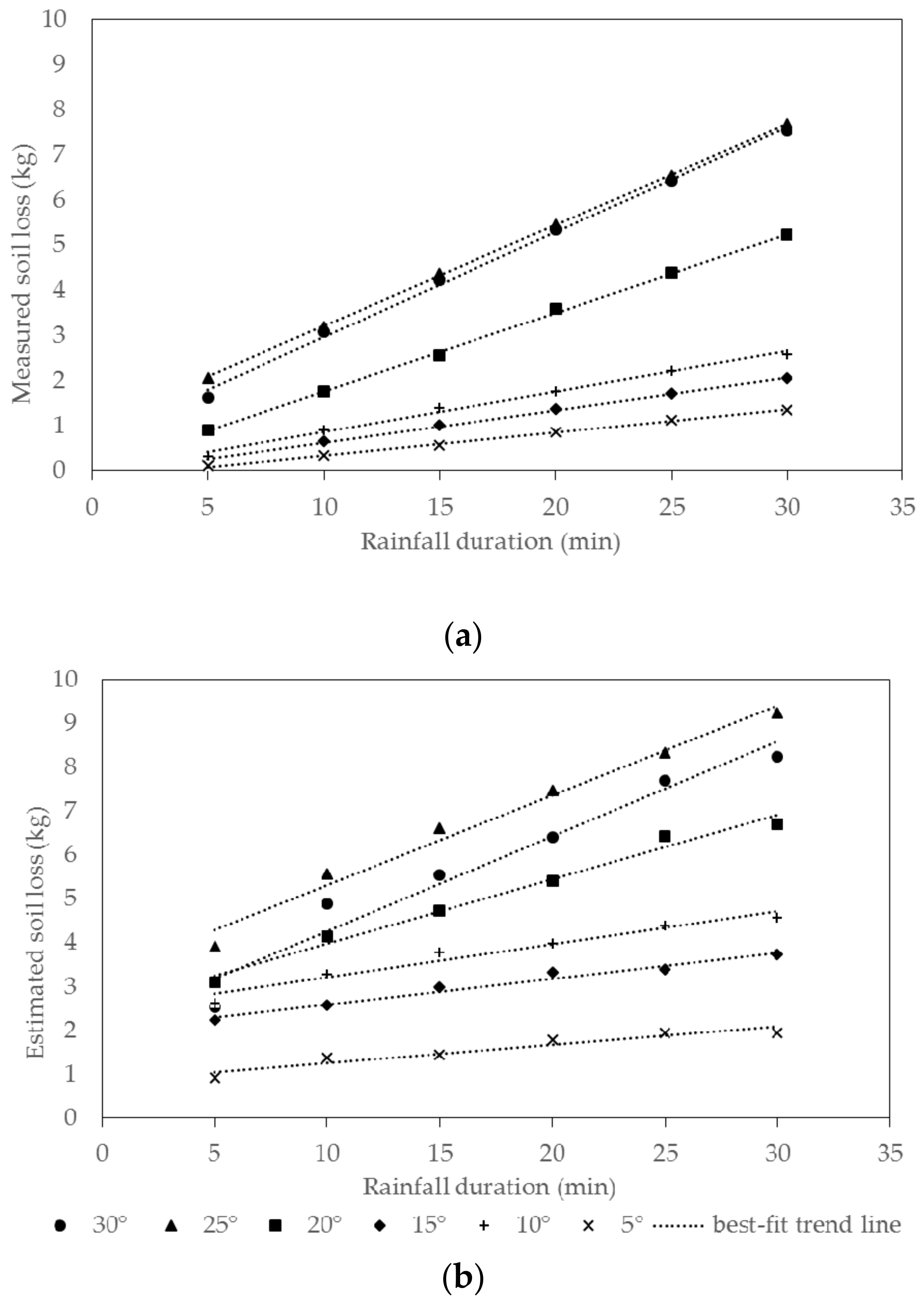
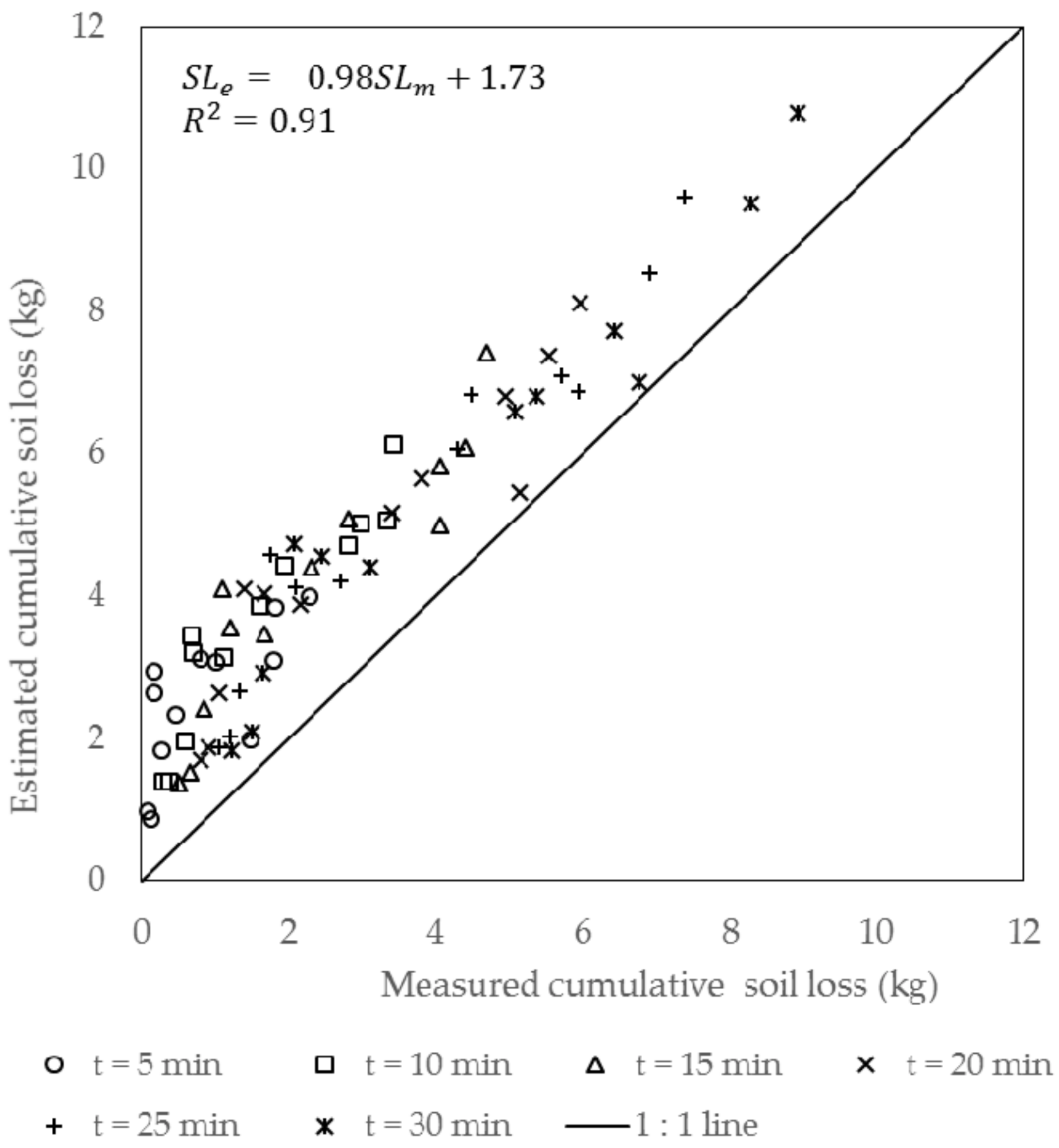
| Index | Cumulative Sediment Yield b (kg) | |||||
|---|---|---|---|---|---|---|
| Slope | Rainfall Duration (min) | |||||
| 5 | 10 | 15 | 20 | 25 | 30 | |
| 30° (1) a | 1.802 | 3.335 | 4.404 | 5.546 | 6.923 | 8.3 |
| 30° (2) a | 1.471 | 2.815 | 4.06 | 5.149 | 5.948 | 6.766 |
| 25° (1) | 1.829 | 2.98 | 4.052 | 4.946 | 5.714 | 6.439 |
| 25° (2) | 2.287 | 3.422 | 4.687 | 5.975 | 7.382 | 8.919 |
| 20° (1) | 1.018 | 1.937 | 2.816 | 3.799 | 4.484 | 5.376 |
| 20° (2) | 0.802 | 1.604 | 2.315 | 3.396 | 4.289 | 5.086 |
| 15° (1) | 0.173 | 0.695 | 1.195 | 1.68 | 2.099 | 2.46 |
| 15° (2) | 0.285 | 0.596 | 0.836 | 1.062 | 1.334 | 1.646 |
| 10° (1) | 0.167 | 0.675 | 1.108 | 1.395 | 1.75 | 2.071 |
| 10° (2) | 0.467 | 1.116 | 1.678 | 2.15 | 2.708 | 3.1 |
| 5° (1) | 0.088 | 0.303 | 0.504 | 0.903 | 1.213 | 1.507 |
| 5° (2) | 0.118 | 0.374 | 0.646 | 0.807 | 1.065 | 1.228 |
| Index | Cumulative Volume-Difference Soil Loss (kg) | |||||
|---|---|---|---|---|---|---|
| Slope | Rainfall Duration (min) | |||||
| 5 | 10 | 15 | 20 | 25 | 30 | |
| 30° (1) a | 3.100 | 5.058 | 6.087 | 7.367 | 8.540 | 9.518 |
| 30° (2) | 1.981 | 4.706 | 4.990 | 5.443 | 6.880 | 6.992 |
| 25° (1) | 3.836 | 5.012 | 5.820 | 6.813 | 7.081 | 7.725 |
| 25° (2) | 3.982 | 6.120 | 7.407 | 8.123 | 9.594 | 10.775 |
| 20° (1) | 3.080 | 4.414 | 5.074 | 5.652 | 6.822 | 6.798 |
| 20° (2) | 3.113 | 3.854 | 4.397 | 5.176 | 6.057 | 6.593 |
| 15° (1) | 2.630 | 3.206 | 3.553 | 4.025 | 4.114 | 4.552 |
| 15° (2) | 1.831 | 1.947 | 2.418 | 2.630 | 2.661 | 2.917 |
| 10° (1) | 2.937 | 3.432 | 4.097 | 4.106 | 4.568 | 4.740 |
| 10° (2) | 2.327 | 3.143 | 3.471 | 3.877 | 4.216 | 4.403 |
| 5° (1) | 0.979 | 1.394 | 1.374 | 1.861 | 2.030 | 2.082 |
| 5° (2) | 0.858 | 1.382 | 1.520 | 1.698 | 1.862 | 1.833 |
| Index | Soil Loss Percentage to the Total Soil Loss | ||
|---|---|---|---|
| Rainfall Duration (min) | Distance from the Outlet | ||
| 45–70 cm | 30–45 cm | 0–30 cm | |
| 5 | 23% | 28% | 49% |
| 10 | 25% | 32% | 43% |
| 15 | 29% | 32% | 39% |
| 20 | 32% | 31% | 37% |
| 25 | 33% | 31% | 36% |
| 30 | 33% | 33% | 34% |
© 2018 by the authors. Licensee MDPI, Basel, Switzerland. This article is an open access article distributed under the terms and conditions of the Creative Commons Attribution (CC BY) license (http://creativecommons.org/licenses/by/4.0/).
Share and Cite
Wang, Y.-C.; Lai, C.-C. Evaluating the Erosion Process from a Single-Stripe Laser-Scanned Topography: A Laboratory Case Study. Water 2018, 10, 956. https://doi.org/10.3390/w10070956
Wang Y-C, Lai C-C. Evaluating the Erosion Process from a Single-Stripe Laser-Scanned Topography: A Laboratory Case Study. Water. 2018; 10(7):956. https://doi.org/10.3390/w10070956
Chicago/Turabian StyleWang, Yung-Chieh, and Chun-Chen Lai. 2018. "Evaluating the Erosion Process from a Single-Stripe Laser-Scanned Topography: A Laboratory Case Study" Water 10, no. 7: 956. https://doi.org/10.3390/w10070956
APA StyleWang, Y.-C., & Lai, C.-C. (2018). Evaluating the Erosion Process from a Single-Stripe Laser-Scanned Topography: A Laboratory Case Study. Water, 10(7), 956. https://doi.org/10.3390/w10070956






